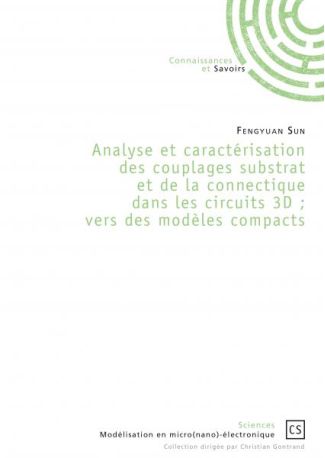Aucun produit
Les prix sont TTC
Produit ajouté avec succès à votre panier
Il y a 0 produits dans votre panier. Il y a 1 produit dans votre panier.
- My Account
- My Wishlist (0)
- No products
- Watch List (1)
- Compare List (0)
- No products to compare.
Analyse et caractérisation des couplages substrat et de la connectique dans les circuits 3D
Delphine Leroy
The proposal of doubling the number of transistors on an IC chip (with minimum costs and subtle innovations) every 24 months by Gordon Moore in 1965 (the so-called called Moore's law) has been the most powerful driver for the emphasis of the microelectronics industry in the past 50 years. This law enhances lithography scaling and integration, in 2D, of all functions on a single chip, increasingly through system-on-chip (SOC). On the other hand, the integration of all these functions can be achieved through 3D integrations . Generally speaking, 3D integration consists of 3D IC packaging, 3D IC integration, and 3D Si integration. They are different and mostly the TSV (through-silicon via) separates 3D IC packaging from 3D IC/Si integrations since the latter two uses TSVs, but 3D IC packaging does not. TSV (with a new concept that every chip or interposer could have two surfaces with circuits) is the heart of 3D IC/Si integrations. Continued technology scaling together with the integration of disparate technologies in a single chip means that device performance continues to outstrip interconnect and packaging capabilities, and hence there exist many difficult engineering challenges, most notably in power management, noise isolation, and intra and inter-chip communication. 3D Si integration is the right way to go and compete with Moore's law (more than Moore versus more Moore). However, it is still a long way to go. In this book, Fengyuan SUN proposes new substrate network extraction techniques. Using this latter, the substrate coupling and loss in IC's can be analyzed. He implements some Green/TLM (Transmission Line Matrix) algorithms in MATLAB. It permits to extract impedances between any number of embedded contacts or/and TSVS. He does investigate models of high aspect ratio TSV, on both analytical and numerical methods electromagnetic simulations. This model enables to extract substrate and TSV impedance, S parameters and parasitic elements, considering the variable resistivity of the substrate. It is full compatible with SPICE-like solvers and should allow an investigation in depth of TSV impact on circuit performance.
- Format papier
32,00 €Ajouter au panier
- Format ebook
9,99 €Acheter l'Ebook
Pas de commentaire




